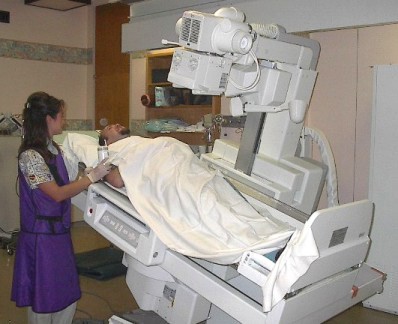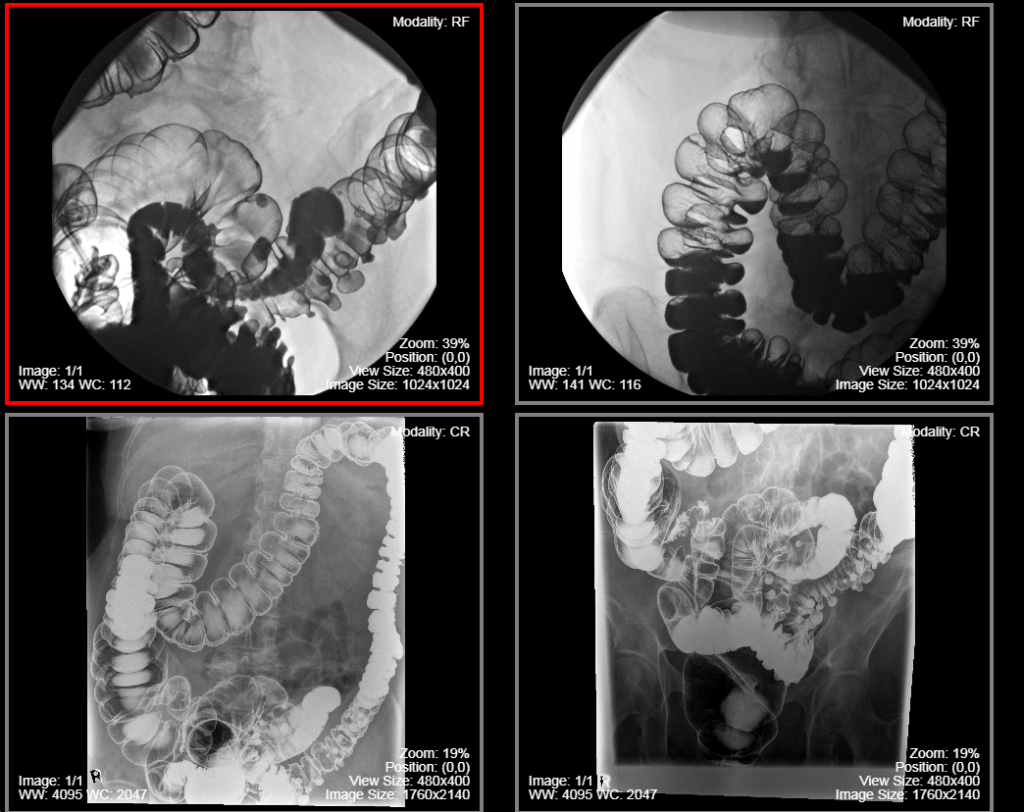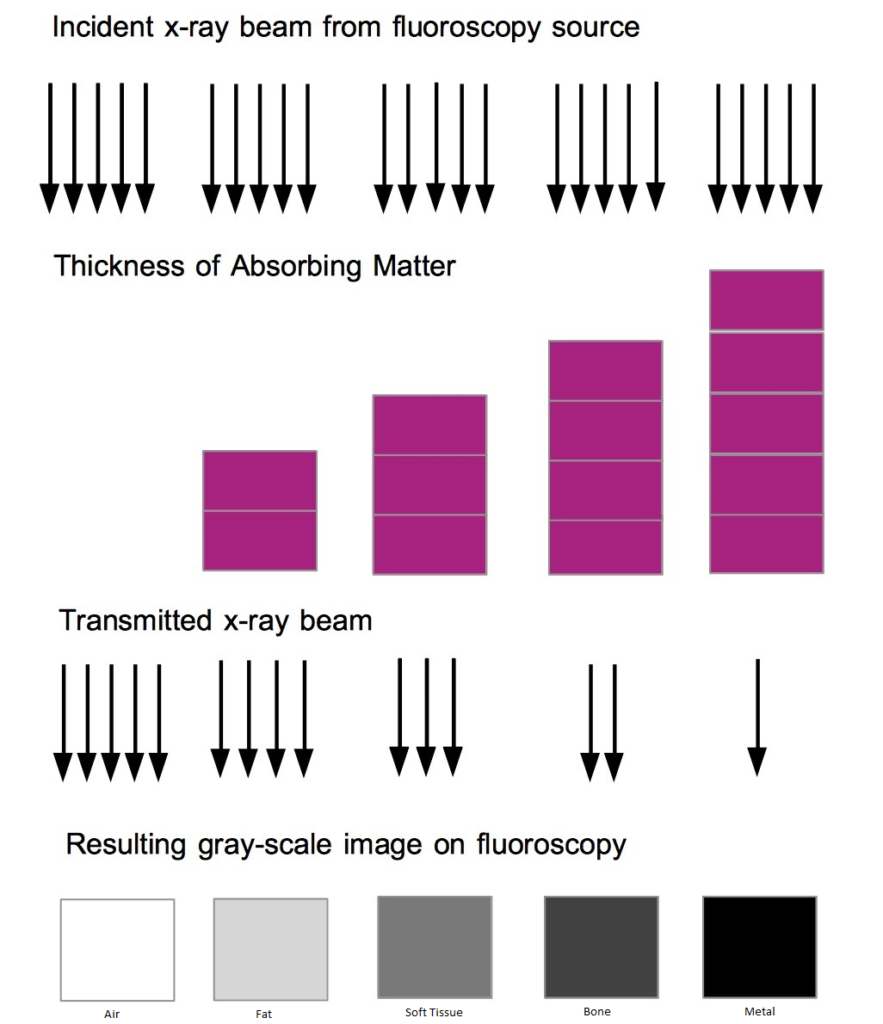21
Fluoroscopy utilizes live x-rays to visualize anatomic structures. The live x-ray beam is activated by the radiologist performing the procedure. It is best utilized for examinations that depict active physical properties such as intestinal peristalsis or swallowing. The image quality in fluoroscopy is controlled by multiple x-ray detectors in the table that adjust the x-ray dose based upon the size and thickness of the tissue being imaged. The field of view of the x-ray exposure can also be controlled to minimize unnecessary exposure of other anatomy. The image can also be magnified to enhance detection of abnormalities.
An example of a fluoroscopic examination is the esophogram and upper gastrointestinal series. The patient is asked to swallow barium sulfate and gas-forming granules. The barium can be seen to move with positioning (gravity) and peristalsis as it moves antegrade through the digestive tract while the gas rises to the highest point of the intestinal tract based upon patient positioning. The barium and the gas help to outline the inner lining of the intestine. The live fluoroscopic x-rays visualize the motion of the barium and the gas. It is also possible to capture still images and/or cine mode images that are stored in the Picture Archive and Communication System (PACS).
Cine mode images are still images captured at a rapid rate and can be viewed sequentially, like a video, after being stored in the PACS. Other fluoroscopy aided examinations include arthrography, barium enema, cystourethrogram, sinus tract injections, myelography and hysterosalpingography, to name a few.
The positioning of the patient is dependent on the physical capabilities of the patient and the exam that is to be performed. For example, when carrying out an esophogram, the best positioning would be an upright (standing) patient and an oblique or lateral view of the anatomy to watch the barium proceeding down the esophagus. Additional oblique and lateral views allow one to visualize abnormalities in multiple planes and to determine if any abnormality of the intestinal mucosa is concealed by swallowed barium on one view. If aspiration of ingested fluid or food into the lungs is clinically suspected the lateral projection allows one to determine if fluids are entering the trachea during swallowing.
A Fluoroscopy machine is seen in Figure 3.15.

Figure 3.16 depicts still images of a barium enema, performed to assess the colon for possible malignant polyps.

The video in Figure 3.17 depicts live fluoroscopy of the upper esophagus for a patient whose images demonstrate aspiration of the barium into the trachea.
Figure 3.17 Fluoroscopy of the Pharynx and Upper Esophagus, video. Video clip available at https://pressbooks.com/app/uploads/sites/66470/2017/10/3.17-Fluoroscopy-cine-2.mp4
Fluoroscopy images are most often displayed for review inverted in comparison to standard x-ray images. Hence, air is white and metal is black. They can also be displayed as standard x-rays if this is advantageous for interpretation, see the barium enema images. The principles of absorption and transmission of the x-rays is unchanged, but the images are digitally manipulated to be the inverse of x-rays, much like film negatives in photography. The effect of image inversion for Fluoroscopy images is depicted in Figure 3.18.

Fluoroscopy:
- Uses live x-rays
- Images are very often inverted compared to conventional x-ray images
- Often use barium sulfate and gas-forming granules as contrast
Examples of Fluoroscopic procedures includes:
- Esophagram
- Upper Gastrointestinal Series
- Arthrogram
- Barium Enema
Attributions
Fig 3.15 A Fluoroscopy Machine by Dr. Brent Burbridge MD, FRCPC, University Medical Imaging Consultants, College of Medicine, University of Saskatchewan is used under a CC-BY-NC-SA 4.0 license.
Fig 3.16 Barium Enema images by Dr. Brent Burbridge MD, FRCPC, University Medical Imaging Consultants, College of Medicine, University of Saskatchewan is used under a CC-BY-NC-SA 4.0 license.
Fig 3.17 Fluoroscopy of the Pharynx and Upper Esophagus, video by Dr. Brent Burbridge MD, FRCPC, University Medical Imaging Consultants, College of Medicine, University of Saskatchewan is used under a CC-BY-NC-SA 4.0 license. Video can be accessed at http://openpress.usask.ca/undergradimaging/wp-content/uploads/sites/34/2017/07/Fluoroscopy-cine-2.mp4. Static images can be accessed at https://mistr.usask.ca/odin/?caseID=20160216105351798.
Fig 3.18 Fluoroscopy Images are Inverted in Comparison to x-rays by Dr. Brent Burbridge MD, FRCPC, University Medical Imaging Consultants, College of Medicine, University of Saskatchewan is used under a CC-BY-NC-SA 4.0 license.
